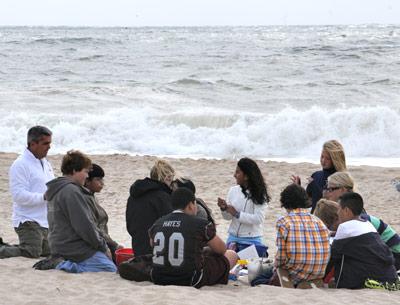Middle School Class Sizes a Concern

Many classes at East Hampton Middle School have swelled in size since school began last month and are nearing 30 students, a number generally regarded by educators as the upper limit. Two classes have more than 30, with 32 eighth graders now squeezed into one section of earth science.
Last spring the East Hampton School Board cut nearly $1 million from the current budget, and some see the larger classes as a direct consequence. Though no teaching positions were eliminated, four teachers district-wide were moved to part-time, according to Patricia Hope, the school board president.
“The first year was fat, and the second year it’s muscle, and next year it’s going to be bone,” said Christina DeSanti, a board member, during a final discussion of the budget in April. Several others on the board echoed the sentiment.
But for some at the middle school, the slicing into bone is already evident. In the eighth-grade science class, 13- and 14-year-olds are packed in like sardines. Lab space is at a premium.
“The conditions are not optimum for teaching at a higher level. Some class sizes are simply not what parents are accustomed to,” said Claude Beudert, who has been co-president with Arthur Goldman of the East Hampton Teachers Association since June. “The state is emphasizing science and technology, and we’re simultaneously being asked to do more with less.”
Mr. Beudert has taught in East Hampton for 38 years, the last 15 at the middle school, where he teaches special education. Until now, he said, class size typically hovered between 16 and 22 students. The expansion is “new as of this fall.”
Classes at or near the magic number include eighth-grade Spanish 1, which started the year with 31 students but was down to 28 as of Tuesday. Eighth-grade English has one class of 32 students and another of 29, and seventh-grade math has two sections approaching 30 students.
“The goal is to have classes at 30 and below,” said Charles Soriano, the middle school principal, during a conversation in his office on Tuesday morning. If a teacher instructs more than 128 students over the course of the school day, their contract stipulates additional compensation.
“Classes overall are loading higher. It’s a consequence of a reduction in sections, but also of gaining more kids in the class,” said Dr. Soriano.
Middle school numbers change every year. This year, the eighth grade has about 30 more students than it did last year. Next year’s sixth grade is predicted to be around 100.
“The teachers are capable of handling the numbers,” said Dr. Soriano. Citing recent research, he said that while the general belief is that smaller classes are better, no optimum class size, in terms of student achievement, has yet been determined. “The question is what does the community want? We haven’t reached a crisis point, but if we keep cutting, we will increase the numbers.”
Deme Minskoff, the middle school’s PTA president, does not recall class size being an issue in previous years. Since last month, she estimated that half a dozen parents have contacted her to express concern. Her own son is an eighth grader who has two classes with more than 30 students.
“I urge parents to speak with the administration and voice their complaints, and if they aren’t satisfied, they need to speak with [Superintendent] Rich Burns and/or the board and go to board meetings,” said Ms. Minskoff. A call to Mr. Burns yesterday was not immediately returned.
Wendy Ricci, whose daughter is also in the eighth grade, expressed frustration that while the one section of earth science has 32 students, another has only 19.
“Couldn’t the schedule have been looked at in a more creative way?” she asked. “As a former teacher, I know that class size makes a difference. Isn’t there a way they could have looked at the schedule and worked on it? I continue to question why it happened, and, more importantly, how it could have been avoided.”
Lisa Benincasa, the science coordinator at the high school, said 20 students was an ideal number for a lab class, though her two sections of AP biology each has 26. “When you have a lab, you try and limit the number of kids,” said Ms. Benincasa. “The state encourages hands-on wet labs, and you need space and equipment to do that.”
Like many others, she blames the state-imposed 2-percent property tax cap.
“I don’t know how you can cut money without cutting programs at some point,” she said. “It absolutely impacts the students.”
Ms. Hope, the school board president, begs to differ.
“As a science teacher, anything over what the room will support in terms of hands-on activity is the cutoff point,” she said. Ms. Hope taught science in East Hampton for 33 years before retiring, and chaired the high school’s science department for eight years.
“With regard to teacher comfort level, the only limiting factor is space for kids to put their hands on things — and that’s up to the teachers,” she said. “It’s crowded, but as long as there are materials and supplies, it’s all good.”
What she does see is a schedule rife with complication, and a situation that might have been avoided had the numbers of students in the two eighth-grade science classes been assigned personally by an administrator, rather than by computer.
Ms. Hope does not see the larger classes as an ominous sign of budgetary things to come. “We’re not looking to increase class sizes at all,” she said. “This was a scheduling glitch.”
